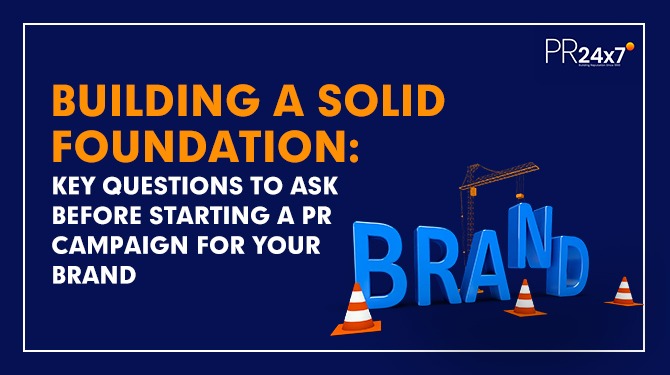
As public relations professionals, we understand that launching a successful PR campaign requires thorough research and preparation. Before embarking on a journey to promote a brand, it is crucial to gather relevant information and gain a comprehensive understanding of the brand’s goals and values. In this article, we will explore the key questions that should be asked before initiating a PR campaign, enabling us to create a strategic and impactful communication plan that aligns with the brand’s objectives.
Mission, Vision, and Core Values
1. What is the brand’s mission and vision?
A brand’s mission and vision lay the foundation for its identity and purpose. By understanding these elements, we can shape the PR campaign to effectively communicate the brand’s core message and resonate with its target audience.
2. What are the brand’s core values?
Core values represent the guiding principles that drive a brand’s actions and decisions. By identifying and aligning with these values, we can develop a PR campaign that showcases the brand’s authenticity and fosters trust among its stakeholders.
Target Audience and Market Perception
3. Who is the target audience for the brand?
Understanding the target audience is vital for crafting messages that resonate with their needs, preferences, and aspirations. By delving into their demographics, behaviors, and psychographics, we can tailor the PR campaign to effectively engage and connect with the desired audience.
4. How does the brand want to be perceived in the market?
Defining the desired market perception helps us shape the brand’s image and reputation. By understanding how the brand wants to be perceived, we can create a PR campaign that strategically positions it in the minds of its target audience, differentiating it from competitors.
Assessing the Brand’s Current Position
5. What are the unique selling points or key differentiators of the brand?
Identifying the brand’s unique selling points helps us highlight its competitive advantages. By emphasizing these differentiators in the PR campaign, we can create a compelling narrative that sets the brand apart and attracts attention.
6. What are the brand’s current public relations and marketing efforts?
By evaluating the brand’s existing PR and marketing initiatives, we can identify strengths, weaknesses, and areas for improvement. This assessment allows us to build upon previous successes and address any challenges in the upcoming campaign.
Long-term Goals and Key Messages
7. Has the brand had any previous PR successes or challenges?
Learning from past experiences provides valuable insights for shaping future campaigns. By understanding previous PR successes and challenges, we can refine our strategies and tactics, maximizing the potential for success.
8. What are the brand’s short-term and long-term goals?
Aligning the PR campaign with the brand’s short-term and long-term goals ensures that our efforts are focused and purposeful. By setting measurable objectives, we can track progress and demonstrate the campaign’s impact.
Communication Channels and Competitor Analysis
9. What are the key messages the brand wants to communicate to the public?
Identifying the key messages enables us to develop compelling storylines and narratives that effectively communicate the brand’s value proposition. By aligning these messages with the target audience’s interests and aspirations, we can create an emotional connection and foster brand loyalty.
10. What are the brand’s preferred channels or platforms for communication?
Understanding the brand’s preferred communication channels helps us select the most suitable platforms for reaching the target audience. By leveraging the right channels, we can amplify the campaign’s reach and engagement.
11. Who are the brand’s main competitors?
Analyzing the competitive landscape allows us to identify gaps, opportunities, and potential threats. By studying the strategies and messaging of competitors, we can create a campaign that differentiates the brand and positions it as a leader in the market.
Partnerships, Events, and Success Metrics
12. What are the brand’s existing partnerships or collaborations?
Collaborations and partnerships can significantly enhance a PR campaign’s impact. By exploring existing partnerships, we can leverage synergies and create mutually beneficial opportunities that boost brand visibility and credibility.
13. Are there any upcoming product launches, events, or initiatives that need PR support?
Being aware of upcoming product launches, events, or initiatives allows us to plan and execute targeted PR activities. By aligning the campaign with these milestones, we can generate excitement, anticipation, and media coverage.
Measurement and Budget
14. What are the brand’s key performance indicators (KPIs) or metrics for success?
Establishing clear KPIs enables us to measure the effectiveness and impact of the PR campaign. By tracking metrics such as media coverage, website traffic, social media engagement, and brand sentiment, we can refine our strategies and demonstrate the campaign’s ROI.
15. What is the budget and timeline for the PR campaign?
Understanding the budget and timeline allows us to allocate resources efficiently and set realistic expectations. By managing these factors effectively, we can optimize the campaign’s execution and ensure its success within the given constraints.
Key Highlights:
- Brand mission, vision, and core values set the foundation for a PR campaign.
- Understanding the target audience and desired market perception is crucial.
- Assessing the brand’s current position helps identify strengths and areas for improvement.
- Long-term goals and key messages guide the campaign’s strategic direction.
- Competitor analysis enables differentiation and positioning strategies.
- Partnerships, events, and success metrics contribute to campaign effectiveness.
- Measurement and budgeting ensure the campaign’s efficiency and ROI.
Conclusion:
A successful PR campaign begins with a comprehensive understanding of the brand, its goals, and its values. By asking the right questions, we can gather the necessary insights to develop a strategic and impactful PR plan. Through aligning our messaging, selecting appropriate channels, and tracking key metrics, we can create a campaign that not only elevates the brand’s reputation but also delivers tangible results. Remember, knowledge is power, and the power of understanding is the driving force behind a successful PR campaign.